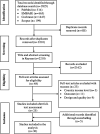Prognostic accuracy of antenatal Doppler ultrasound for adverse perinatal outcomes in low-income and middle-income countries: a systematic review
- PMID: 34857564
- PMCID: PMC8640672
- DOI: 10.1136/bmjopen-2021-049799
Prognostic accuracy of antenatal Doppler ultrasound for adverse perinatal outcomes in low-income and middle-income countries: a systematic review
Abstract
Objectives: This systematic review examined available literature on the prognostic accuracy of Doppler ultrasound for adverse perinatal outcomes in low/middle-income countries (LMIC).
Design: We searched PubMed, Embase, Cochrane Library and Scopus from inception to April 2020.
Setting: Observational or interventional studies from LMICs.
Participants: Singleton pregnancies of any risk profile.
Interventions: Umbilical artery (UA), middle cerebral artery (MCA), cerebroplacental ratio (CPR), uterine artery (UtA), fetal descending aorta (FDA), ductus venosus, umbilical vein and inferior vena cava.
Primary and secondary outcome measures: Perinatal death, stillbirth, neonatal death, expedited delivery for fetal distress, meconium-stained amniotic fluid, low birth weight, fetal growth restriction, admission to neonatal intensive care unit, neonatal acidosis, Apgar scores, preterm birth, fetal anaemia, respiratory distress syndrome, length of hospital stay, birth asphyxia and composite adverse perinatal outcomes (CAPO).
Results: We identified 2825 records, and 30 (including 4977 women) from Africa (40.0%, n=12), Asia (56.7%, n=17) and South America (3.3%, n=01) were included. Many individual studies reported associations and promising predictive values of UA Doppler for various adverse perinatal outcomes mostly in high-risk pregnancies, and moderate to high predictive values of MCA, CPR and UtA Dopplers for CAPO. A few studies suggested that the MCA and FDA may be potent predictors of fetal anaemia. No randomised clinical trial (RCT) was found. Most studies were of suboptimal quality, poorly powered and characterised by wide variations in outcome classifications, the timing for the Doppler tests and study populations.
Conclusion: Local evidence to guide how antenatal Doppler ultrasound should be used in LMIC is lacking. Well-designed studies, preferably RCTs, are required. Standardisation of practice and classification of perinatal outcomes across countries, following the international standards, is imperative.
Prospero registration number: CRD42019128546.
Keywords: fetal medicine; prenatal diagnosis; ultrasonography; ultrasound.
© Author(s) (or their employer(s)) 2021. Re-use permitted under CC BY. Published by BMJ.
Conflict of interest statement
Competing interests: None declared.
Figures
Similar articles
-
Peripartum fetal Doppler sonography and perinatal outcome: a systematic review and meta-analysis.BMC Pregnancy Childbirth. 2025 May 8;25(1):545. doi: 10.1186/s12884-025-07586-0. BMC Pregnancy Childbirth. 2025. PMID: 40340553 Free PMC article.
-
Role of Doppler ultrasound at time of diagnosis of late-onset fetal growth restriction in predicting adverse perinatal outcome: prospective cohort study.Ultrasound Obstet Gynecol. 2020 Jun;55(6):793-798. doi: 10.1002/uog.20406. Epub 2020 May 8. Ultrasound Obstet Gynecol. 2020. PMID: 31343783
-
Middle cerebral arterial flow redistribution is an indicator for intrauterine fetal compromise in late pregnancy in low-resource settings: A prospective cohort study.BJOG. 2022 Sep;129(10):1712-1720. doi: 10.1111/1471-0528.17115. Epub 2022 Feb 24. BJOG. 2022. PMID: 35118790 Free PMC article.
-
Cerebroplacental ratio assessment in early labor in uncomplicated term pregnancy and prediction of adverse perinatal outcome: prospective multicenter study.Ultrasound Obstet Gynecol. 2019 Apr;53(4):481-487. doi: 10.1002/uog.19113. Epub 2019 Mar 4. Ultrasound Obstet Gynecol. 2019. PMID: 29900608
-
Predictive accuracy of cerebroplacental ratio for adverse perinatal and neurodevelopmental outcomes in suspected fetal growth restriction: systematic review and meta-analysis.Ultrasound Obstet Gynecol. 2018 Oct;52(4):430-441. doi: 10.1002/uog.19117. Epub 2018 Sep 5. Ultrasound Obstet Gynecol. 2018. PMID: 29920817
Cited by
-
Fetal and Neonatal Middle Cerebral Artery Hemodynamic Changes and Significance under Ultrasound Detection in Hypertensive Disorder Complicating Pregnancy Patients with Different Severities.Comput Math Methods Med. 2022 Jun 28;2022:6110228. doi: 10.1155/2022/6110228. eCollection 2022. Comput Math Methods Med. 2022. PMID: 35799667 Free PMC article.
-
Prognostic Accuracy of Antenatal Doppler Ultrasound Measures in Predicting Adverse Perinatal Outcomes for Pregnancies Complicated by Diabetes: A Systematic Review.AJOG Glob Rep. 2023 Jun 10;3(3):100241. doi: 10.1016/j.xagr.2023.100241. eCollection 2023 Aug. AJOG Glob Rep. 2023. PMID: 37396341 Free PMC article. Review.
-
The relationship between maternal uterine artery doppler ultrasound during the second and third trimesters and infant cognitive development at one year of age: Findings from a South African prospective cohort study.PLoS One. 2025 Jun 6;20(6):e0322806. doi: 10.1371/journal.pone.0322806. eCollection 2025. PLoS One. 2025. PMID: 40479629 Free PMC article.
-
Prevalence and Factors Associated With Abnormal Cerebroplacental Ratio Among Women With Hypertensive Disorders of Pregnancy at a Tertiary Referral Hospital in Southwestern Uganda.J Pregnancy. 2024 Oct 17;2024:8895971. doi: 10.1155/2024/8895971. eCollection 2024. J Pregnancy. 2024. PMID: 39449739 Free PMC article.
-
Peripartum fetal Doppler sonography and perinatal outcome: a systematic review and meta-analysis.BMC Pregnancy Childbirth. 2025 May 8;25(1):545. doi: 10.1186/s12884-025-07586-0. BMC Pregnancy Childbirth. 2025. PMID: 40340553 Free PMC article.
References
Publication types
MeSH terms
LinkOut - more resources
Full Text Sources
Miscellaneous


